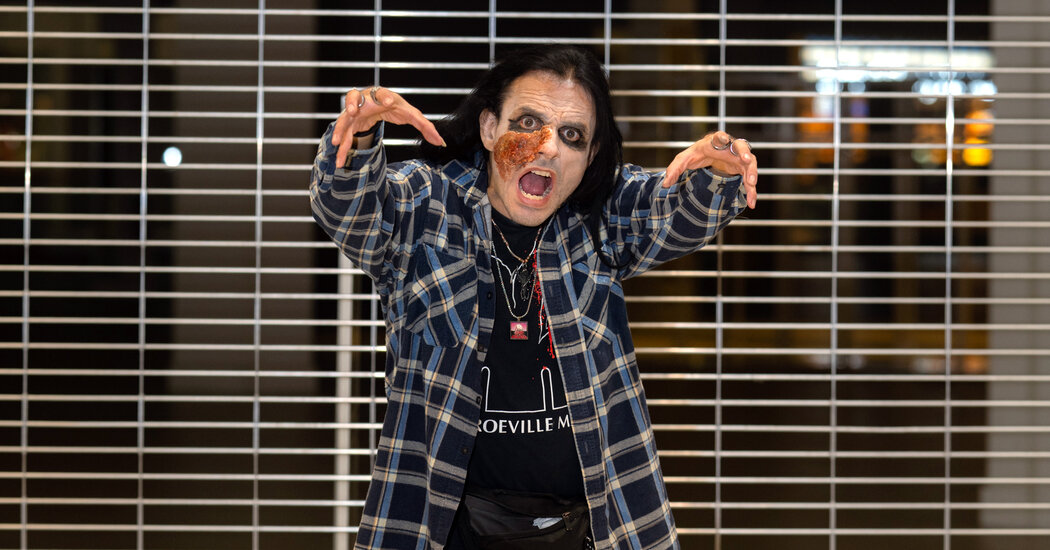I had already visited the Monroeville Mall dozens of times before I moved to Pittsburgh.
This was because, as a young horror fan, I watched George A. Romero’s 1978 zombie horror film “Dawn of the Dead,” which was filmed there, over and over again. I watched it so many times, I knew that the elevated perch outside the department store was the best strategic vantage point; that supplies necessary to survive a zombie apocalypse could be found in the gourmet grocer shop and the guns and ammo outlet; and of course, the best (and worst) escape routes if I were being pursued by a slow-moving but insatiably hungry mass of the living dead out to consume my flesh.
Mr. Romero is one of America’s most influential independent filmmakers, who created the zombie as we know it, with its relentless undead shuffling, terrifyingly infectious bite and vulnerability to a bullet in the brain. The mall may look unassuming at first glance, but thanks to Mr. Romero, it’s become a pilgrimage site for horror fans.
It won’t be one for long. The mall, which opened in the suburbs of Pittsburgh in 1969, has transformed over time from a state-of-the-art shopping mecca to something closer to a zombie mall. In the coming years, it will be entirely demolished and replaced by a Walmart-owned mixed-use space.
In late October, fans from all over the world gathered there for what could potentially be one of the last Living Dead Weekends held at the mall, to pay our respects to “Dawn of the Dead,” Mr. Romero and the horror genre. I’ve been wondering what our mall’s impending demise says about the zombies that made it famous. What does it mean when a cultural epicenter is poised to be little more than a dearly departed corpse?
Part of the miracle of the mall is that it really had not changed all that much between 1978, when the film was released, and 1999, when I made my first pilgrimage there. It was the mall I had first seen onscreen in 1983, when I used my bar mitzvah gifts to buy the astonishing invention known as the VCR and a VHS videocassette of “Dawn of the Dead.” Other movies I could rent, but I knew even before seeing it that this was one I had to own.
Being serious about horror means being serious about Mr. Romero, master of the socially-conscious horror film. His debut feature, “Night of the Living Dead,” ferociously captured the cultural mood of 1968. In that film, the best hope for humanity against the zombie onslaught is a resourceful Black man who survives just long enough to be killed by an all-white posse of militiamen who are supposed to be his rescuers. Mr. Romero had finished the film before the assassination of the Rev. Dr. Martin Luther King Jr., but audiences did not see it until afterward. “Night of the Living Dead” soon became a midnight movie, a countercultural sensation. Its sequel doubled down on the original’s instinct for social critique.
In “Dawn of the Dead,” released 10 years later, a small group of survivors fleeing the zombie apocalypse stumbles upon the mall. They realize it could be their salvation. What better refuge from a precarious, terrifying existence spent running from a horde of zombies who want to feast on them?
Once the survivors lock and barricade all the entrances to the mall and kill all of the zombies inside, they find themselves alone in a shopper’s heaven. They have every product they could ever want, all for free at their fingertips, without ever having to share any of it with anyone else. As the film unfolds, the survivors struggle not with the zombies, but with the way their consumerist paradise curdles into a soul-sucking prison. “I shop, therefore I am,” turns from ecstatic liberation to spiritual incarceration. If consuming is all that life means, then it turns out, life is pretty meaningless.
The zombies, on the other hand, suffer from no such existential crises. They continue to claw in vain at the mall’s sealed doors, day and night. The survivors figure out that the zombies are not so much attracted to them, but to the mall itself. This was a place that was so significant in the zombies’ human lives that even in their shambling, undead form, they feel compelled to return there. The zombies may not be human anymore, but they are still very much consumers. In fact, they have become the ultimate consumers: creatures with a bottomless appetite for feasting on the flesh of the living, yet driven by desires instilled by consumer capitalism that prove even stronger.
At every turn, “Dawn of the Dead” invites us to consider whether the real zombies are the undead desperate to enter the mall or the living humans equally desperate to keep the mall to themselves. Both groups are equally enslaved by the blind need to consume. The more they have, the more they want, and the less satisfied they feel. When we look at those zombies, aren’t we all really looking at ourselves?
Mr. Romero knew that change is essential for survival. Over the course of four decades and five sequels to “Night of the Living Dead,” he constantly revised his formula of socially conscious horror to adapt to the shifting times. His zombies evolved, too, gradually picking up skills like basic tool use, limited problem-solving, and even the glimmers of rudimentary speech. In his 2007 film “Diary of the Dead,” a group of survivors making the long trek from Pittsburgh to Philadelphia are threatened not only by the zombies, but by their own compulsive need to record everything they experience and share it on the internet. Sound familiar?
Many of the mall’s once-bountiful stores now sit empty or closed; to walk through the thinly populated space on a weekday is to confront an uncanny echo of a time long past. Our contemporary image of consumer hunger is not a mall, but a smartphone screen. We’re not strolling between stores, but scrolling our social media feeds.
Yet the blank gaze of the consumer is the same: hypnotized, listless, zombielike.
Adam Lowenstein is the director of the Horror Studies Center at the University of Pittsburgh and the author of “Horror Film and Otherness.”
Jake Reinhart is a photographer based in Pittsburgh.
The Times is committed to publishing a diversity of letters to the editor. We’d like to hear what you think about this or any of our articles. Here are some tips. And here’s our email: [email protected].
Follow the New York Times Opinion section on Facebook, Instagram, TikTok, Bluesky, WhatsApp and Threads.
The post Dawn of the Zombie Mall appeared first on New York Times.




